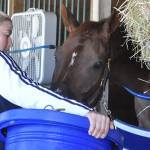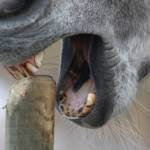Complexity of Wound Healing in Horses Thwarts Treatment Efforts

Skin wounds are frequently encountered in horses, and complications commonly occur during the wound healing process. As a result of those complications, wounds can become contaminated and infected, require prolonged treatment, result in exuberant granulation tissue (“proud flesh”), or heal with excessive scarring.
“Wound healing is a complex series of events, and commercial or veterinary products and procedures that expedite the process are in demand by horse owners,” said Kathleen Crandell, Ph.D., a nutritionist for Kentucky Equine Research.
Examples of products being explored to support wound healing include bacterial cellulose hydrogel with alginate (BCA) and frog skin (FS). Bacterial cellulose, as the name implies, is produced by bacteria and aids in wound healing. Studies show bacterial cellulose increases blood perfusion and tissue metabolism in wounds. Alginate mimics the extracellular matrix and helps maintain moisture at the wound site. The combination of bacterial cellulite and alginate forms hydrogels that promote wound debridement and wound healing.
“Frog skin has been used in human medicine since the 1500s and is reportedly an effective biological dressing that enhances wound healing and exerts antimicrobial activity,” Crandell said.
To determine if either BCA or FS had beneficial effects on the healing of experimentally induced wounds in horses, five healthy adult horses were recruited. Three full-thickness 3 cm2 skin flaps were excised from the lumbar region of each horse. One wound on each horse was treated with BCA, FS, or left as an untreated control. Dressings were applied daily for 28 days. Wounds were evaluated on day 0, 3, 7, 14, 21, and 28 of the study. Clinical features of the wounds (e.g., swelling, bleeding, exudate, granulation tissue development) were noted and measurements to determine wound contraction rates were taken. Additionally, wounds were microscopically evaluated to assess inflammation.*
“Despite the promising results in other species, as reported by the researchers, this study did not reveal any pro-healing effects by the BCA or FS,” Crandell explained.
“These findings highlight the complexity of wound healing across species and limitations of these dressings in equine management,” wrote the researchers.
Additional studies are needed, however, given the high prevalence of skin wounds in horses and the list of complications associated with wound healing.
According to Crandell, “Providing a nutritionally balanced diet and supplementing horses with the omega-3 fatty acids DHA and EPA, found in EO-3, have been shown to support resolution of inflammatory skin conditions and can promote healing.”
Here are other ways researchers are looking to support wound healing in horses:
- Honey for Wound Healing in Horses
- Wound Healing in Horses: Research on Light Therapy
- Oral Stem Cells Help Heal Wounds in Horses
*Campebell, R.C., A.B. Oliveira, J.L.A. Fagundes, B.N.A. Fortes, H.C. Veado, I.L. Macedo, B.S.L. Dallago, H.S., Barud, J. Adorno, P.A.V. Salvador, P.S. Santos, and M.B. Castro. 2025. Evaluation of bacterial cellulose/alginate-based hydrogel and frog skin dressings in equine skin wound healing. Gels 11(2):107.







